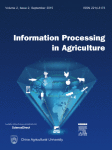Ver ítem
- xmlui.general.dspace_homeCentros Regionales y EEAsCentro Regional Buenos Aires NorteEEA PergaminoArtículos científicosxmlui.ArtifactBrowser.ItemViewer.trail
- Inicio
- Centros Regionales y EEAs
- Centro Regional Buenos Aires Norte
- EEA Pergamino
- Artículos científicos
- Ver ítem
Relationship between MODIS-NDVI data and wheat yield : a case study in northern Buenos Aires province, Argentina
Resumen
In countries like Argentina, whose economy depends heavily on crop production, the estimation of harvests is an elementary requirement. Besides providing objectivity, the use of remote sensing allows estimating yield in advance. Since the time of maximum leaf area in wheat corresponds with the critical period of the crop, a good relationship is expected between the Normalized Difference Vegetation Index (NDVI) and yield. The present study was carried out
[ver mas...]
In countries like Argentina, whose economy depends heavily on crop production, the estimation of harvests is an elementary requirement. Besides providing objectivity, the use of remote sensing allows estimating yield in advance. Since the time of maximum leaf area in wheat corresponds with the critical period of the crop, a good relationship is expected between the Normalized Difference Vegetation Index (NDVI) and yield. The present study was carried out in the North of Buenos Aires province, Argentina. Based on the type of soil, the study area can be divided into two homogeneous subzones: a subzone with lower clay content in the southwest and a subzone with higher clay content in the northeast. Nine growing seasons (2003–2011) were studied. In the first five years, an empirical model was calibrated and validated with field-observed wheat yields and MOD13q1 product-NDVI data, whereas in the other four years, the calibrated model was applied by means of yield maps and by comparing with official yields. The MOD13q1 image corresponding to Julian day 289 showed the best fit between NDVI and yield to estimate wheat yield early. Through yield maps, better weather conditions showed higher yields and higher soil productivity presented a greater proportion of the area occupied by higher yields. At department level, an R2 value of 0.75 was found after relating the estimation of the calibrated empirical model with official yields. The method used allows predicting wheat yield 30 days before harvest. Through yield maps, the NDVI perceived the temporal and spatial variability in the study area.
[Cerrar]

Autor
Lopresti, Mariano Francisco;
Di Bella, Carlos Marcelo;
Degioanni, Américo José;
Fecha
2015-07-18
ISSN
2214-3173
Formato
pdf
Tipo de documento
artículo
Palabras Claves
Derechos de acceso
Restringido
 Excepto donde se diga explicitamente, este item se publica bajo la siguiente descripción: Creative Commons Attribution-NonCommercial-ShareAlike 2.5 Unported (CC BY-NC-SA 2.5)
Excepto donde se diga explicitamente, este item se publica bajo la siguiente descripción: Creative Commons Attribution-NonCommercial-ShareAlike 2.5 Unported (CC BY-NC-SA 2.5)

